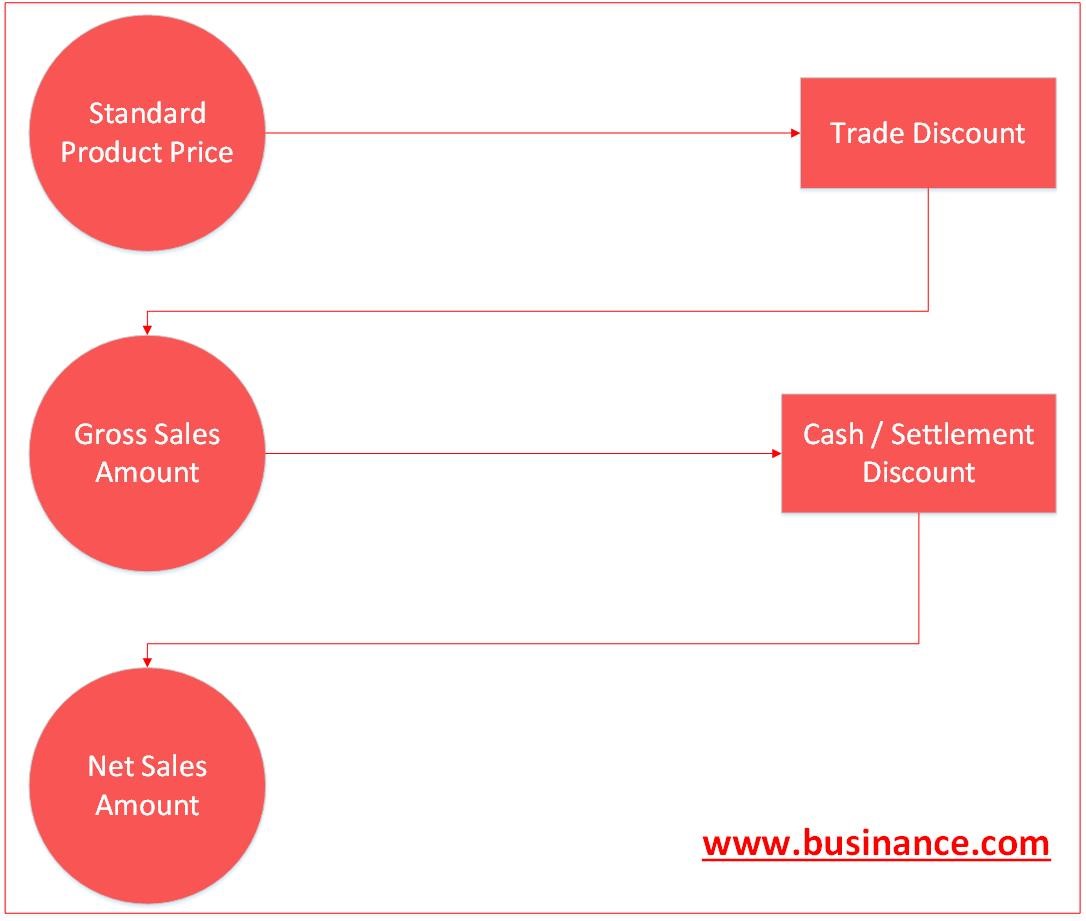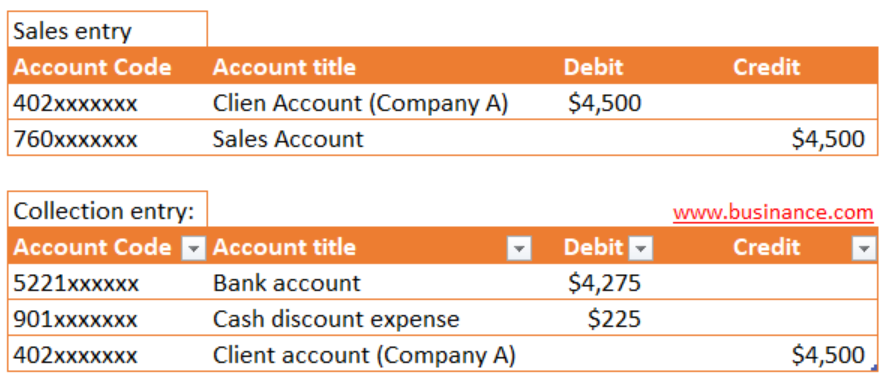[vc_row][vc_column][vc_column_text]A discount is kind of a concession or waiver from the original obligation.
For example, if a prisoner is jailed for four years but is released after four years, he has got a discount of one year. Now, this example is not in business context, but to explain the discount.
In a business context, if a company had to pay $100 to a supplier and the supplier offered to make payment of $95 only against full settlement, it means that the supplier has given a discount of $5.
Trade Discount (or bulk discount)
A trade discount is a discount which is given at the time of trading (i.e., the discount given at the time of making the deal).
For example, you get a quotation from a car dealer for annual maintenance contract of the car at a price of $500. Now, you want them to lower their price as if you feel that it is high. If they agree to bring it down to, say, $450, it means that you have been given a trade discount.
Normally trade discount is offered when a bulk purchase is made. For example, if standard price of a watch is $100 and you want to purchase ten such watches, you might be offered a bulk purchase discount of 10% on total price. In this case, you will have to pay only $900 (instead of $1,000) for ten watches.
Another reason of offering a trade discount is the long term relation between customer and supplier. If there is a longstanding customer, the supplier may be willing to sale products at a discounted price than standard rate.
Some suppliers who are relatively new in business would consider offering trade discounts to new customers as well in order to make long term relations with them.

Accounting entries for trade discounts:
The general ledger entries done by bookkeepers for trade discounts or bulk discounts is usually, not recorded in the books of accounts of the company. This is because sales value has to be booked as per the contractual terms agreed between customer and seller.
For example, if a company sells a trolley bag at a price of $45 whose standard price is $50, it means that the company has offered a trade discount of $5 to its customer. Now, the deal is done at $45 and therefore, applicable accounting standards would require sales amount to be booked at the value of the consideration agreed between parties. The accounting entry for this sale will be as follows:
Debit: Customer account $45
Credit: Sales Account $45
As you can see above, there is no space available for the discount to be recorded as account double entry is of equal amounts on debit and credit sides.
Needs for recording trade discounts:
However, from a management reporting point of view, financial analysts would want to know how much trade discount was offered to the customers during a particular month or a year. Similarly, to which customers trade discount was offered and by how much. From an internal and external audit point of view, auditors would want to check if the approvals for trade discounts were properly obtained. From an internal controls point of view, management would be keen to ensure that no unauthorized approvals are given for the trade discounts.
All of above requirements (management information system, audits, internal controls, performance measurement, sales performance etc.) require that trade discounts should be recorded and reported appropriately.
Recording trade discounts:
Although we cannot record trade discounts in our accounting books as this is prohibited by GAAP. But we can incorporate this in our management information system (MIS). A good MIS would have standard price of each product in the system. Any trade discount offered by sales team (after due approvals) would be entered in system and system would keep the record of trade discount offered. Later on, a report can be extracted from system for performing various types of analysis on discounts offered. However, this discount will not be reported in the company’s income statement.

Cash discount or Settlement Discount
Cash discount (or settlement discount) is an incentive offered to the customer for making early payment.
For example, if a customer has a credit period of 30 days for payment of $1,000, you can offer them an early settlement discount (or cash discount) of 2% if they make the payment within 10 days of the sale.
It is important to understand that cash discount does not necessarily require a ‘cash’ payment. The real objective of cash discount is to incentivize early settlement of the outstanding amount. Payment can be made using any mode like cash, cheque, bank transfer or credit card etc. As long as payment is made within the required time period, the customer will be eligible for the discount. Therefore, the cash discount may also be referred to as cheque discount, bank transfer discount, credit card discount, paypal discount etc. However, these terms are not common.

Accounting for Cash discount:
The cash discount shall be recorded in the books of accounts of the company as an expense. The cash discount will be booked as debit entry in the cash discount expense account and the respective credit will be provided to client’s account.
Cash discount is an expect for the company and thus will be classified in P&L as discount expense. In profit and loss account gross sales shall be reported as a top line. The discount given shall be then subtracted to arrive at net sales revenue figure.
Comprehensive example for cash discount:
Let’s say that Company A purchases 50 units of leather jackets at a credit period of 30 days, from an online retailer of leather jackets (i.e., www.smartleatherjackets.com). The standard price of these jackets is $100 per jacket. The supplier agrees to provide a 10% trade discount and additionally offers to provide 5% of settlement discount if payment is made within 5 days. Assuming that Company A makes payment within 5 days and avails cash discount. The accounting entries shall be recorded as follows in the books of supplier.

Deciding when to provide cash discount
When a company would want to offer cash discount is not an easy question. Financial analysts have to make carefully opportunity cost analysis to find out whether it is worthwhile offering cash discount or not. A cash discount offered will help in faster collection of receivables and thus interest cost of financing working capital (receivables) can be lowered. On the other hand, the amount of discount offered will be expense for the company. So, a cost benefit analysis has to be done. If the company is spending significantly on working capital investment and the early collection benefit is higher than the amount of discount offered, then offering discount is worthwhile. On the other hand, if the company is not incurring significant cost of financing working capital and there is no hurry to collect money from the customer, then offering discount will be expensive for the company. These decisions require significant study and analysis.
Practices of discounts in different industries
Retail or FMCG Sector
In retail sector, trade discount is most common. As an ordinary customer, if you enter a retail store, you might find some products on discount. Often in a sales promotion, you might get upto 50% off or 75% off etc. All this is practical example of trade discount.
There is no cash/settlement discount, usually, in retail sector for retail customers. However, corporate customers may still obtain a cash/settlement discount, in addition to trade discount.

Real estate sector
Cash discount/ settlement discount is quite common when it comes to buying a property. Many project plans offer 10% off or 5% off on full settlement of property price. This is a good practical example of cash/settlement discount in real estate sector.
Financial / banking sector
Often banks offer a settlement discount if you choose to close your mortgage by making a full payment of the total outstanding liability. This is an example of cash/settlement discount. However, this policy varies from place to place. Some banks charge a penalty for early settlement as well.

Electronics industry
If you are ordering bulk quantities of electronics equipement (say mobiles, headsets, chargers, powerbanks etc.) from China, you are likely to receive good trade discount. This means that you’ll get, say, 20% or 30% off on the standard product retail price. Trade discount is common across industries when it comes to buying in bulk quantities.
Conclusion
Understanding trade and cash discounts is relatively a simple topic. By now, you would be aware of nature of discounts, accounting entries and application of discounts in different industries. Providing discounts is an important economic phenome and it there are psychological implications of discounts as well. We will cover further details about discounts in more articles.[/vc_column_text][/vc_column][/vc_row]


